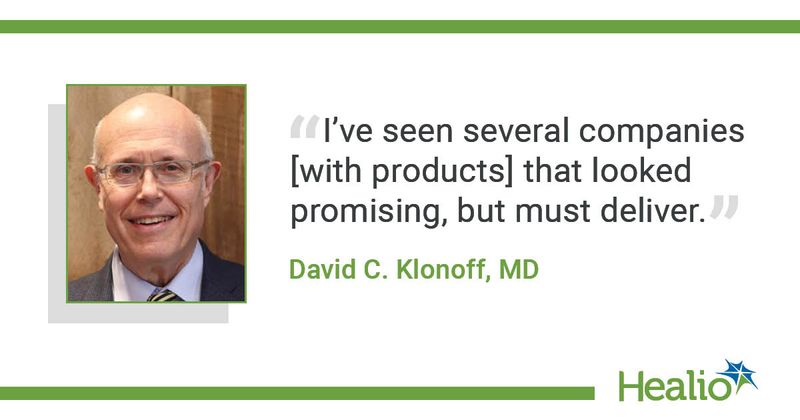Noninvasive glucose monitoring may change future of diabetes management
More than 60 noninvasive and minimally invasive bloodless glucose monitoring products are available or in development, and the devices may become important digital tools for people with diabetes, according to a review article.
David C. Klonoff, MD, medical director of the Diabetes Research Institute at Mills-Peninsula Medical Center in San Mateo, California, said noninvasive glucose monitoring devices could be game changers in the field of diabetes, but several hurdles must be overcome to allow more people to use the products.

“We wrote this article for a couple of reasons,” Klonoff told Healio. “First was to see what’s out there, and to my knowledge, no one has looked at all the different products in development for measuring blood sugar without blood. No. 2, there is a way of measuring glucose that doesn’t exactly fit into any of these categories. We defined a certain type of test method that is neither noninvasive nor minimally invasive, called noninvasive fluid sampling."
Klonoff and colleagues conducted a review of three types of glucose monitoring devices. Noninvasive optical glucose monitoring is described as a device in which radiation is passed through a vascular region of the body. Noninvasive fluid sampling includes devices in which body fluid is collected without puncturing the skin. Minimally invasive glucose monitoring includes devices in which a sensor provides glucose concentration over an extended period of time with a single insertion into the skin with minimal pain.
Approval of noninvasive devices rare
Researchers searched PubMed, Google Patents and the Diabetes Technology Society’s three startup showcases for minimally invasive or noninvasive glucose monitoring products. Seven experts in the field of glucose monitoring were also asked to provide names of novel minimally or noninvasive devices they had heard about. Devices receiving FDA clearance or a CE mark were included, as well as products that had a news article or press release published on Google News starting in 2016. All products were classified as noninvasive optical, noninvasive fluid sampling or minimally invasive. For each product, researchers determined the mechanism of glucose sensing, where the glucose sensing is carried out, accuracy, possible interference, measurement cycle, pricing, size, advantages and disadvantages. The findings were published in Journal of Diabetes Science and Technology.
There were 65 products reviewed: 28 noninvasive optical products, six noninvasive fluid-sampling devices and 31 minimally invasive glucose monitoring products. Of the noninvasive optical and fluid-sampling products, none have received FDA approval and four received CE clearance.
“Generally speaking, it’s more challenging, more rigorous to get FDA clearance than CE clearance,” Klonoff said. “FDA clearance demands safety and effectiveness. CE generally demands only safety. You could have a product, in theory, that is safe, it’s not going to hurt anybody or damage them by using it, but it’s just not very accurate, so it’s not very effective.”
Barriers for noninvasive glucose monitoring
Noninvasive devices face several technological and nontechnological barriers before more are approved and used by a large group of people with diabetes. Accuracy is a big concern and requires more sensitive sensing technologies and better algorithms to convert sensor signals into glucose values, according to Klonoff.
“The smaller the product is, the more difficult it is to make it accurate,” Klonoff said. “As you shrink the components, sometimes they don’t work as well. Maybe you’re using multiple frequencies of light, in a big device, you have room for that. If you make a small device that you can wear, there’s just not enough room to use all those frequencies, you have to sacrifice those frequencies.”
Another technological barrier is getting a better understanding of how to convert bloodless measurements to glucose values. Additionally, physicians need a better understanding of clinical glucose measurements in fluids other than blood.
There are several nontechnological barriers to overcome, including the cost of the products, ease of use for wearers, and an acceptance from people to wearing a continuous device.
“The overall strategy is to provide a glucose sensing technology that does not require a needle to puncture the skin and simultaneously reduces waste, increases convenience and saves money,” the researchers wrote.
For bloodless noninvasive glucose monitoring to continue improving, superior analytic performance, robust algorithm development, traceability testing for glucose-containing matrices besides blood, and appreciation for the clinical value of interstitial fluid glucose measurements are needed, according to the researchers. However, Klonoff said, it is only a matter of time before a company is able to put all of the pieces together.
“Both hardware and software are improving,” Klonoff said. “There are a number of new sensors that could be used, and there are new forms of machine learning on computer chips that can be harnessed. With improvements in those two areas, I’m optimistic. I’ve seen several companies that looked promising, but must deliver.”
For more information:
David C. Klonoff, MD, can be reached at dklonoff@diabetestechnology.org.
